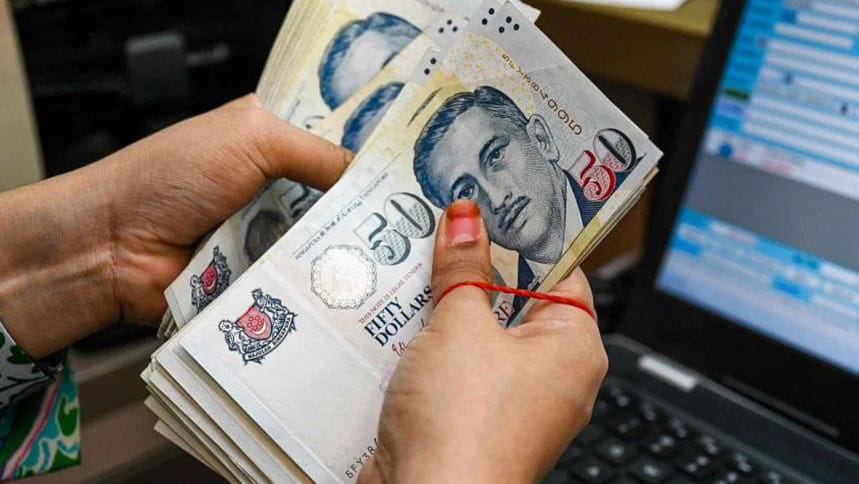Singapore dollar to hold its ground in 2023

The Singapore dollar is set to end the year as Asia's most resilient currency against an exceptional surge in the United States dollar.
But as the global macroeconomic environment changes in 2023 – significantly slowing growth and peaking inflation – some of its regional peers are likely to outperform it.
To date this year, the Singdollar is up 0.03 per cent against the mighty US dollar, which has overwhelmed virtually all currencies worldwide.
The US dollar's spike against most other currencies was backed by the most aggressive interest rate hikes in decades by its central bank – the Federal Reserve – which lifted its benchmark federal funds rate by 4.25 percentage points in just nine months.
The rally crushed other major currencies, including the euro and the British pound.
The year-to-date losses of the Japanese yen stands at 14.7 per cent, while the Chinese renminbi, South Korean won and Taiwan dollar have all lost between 7 per cent to 10 per cent, with the Malaysian ringgit down by 6.4 per cent.
The Singdollar's resilience owe much to the country's decision to start lifting Covid-19 curbs earlier than most of its Asian peers, boosting market confidence on the strength of its economic recovery.
The policy stance of the Monetary Authority of Singapore (MAS) has also helped the local currency.
It was among the few central banks to start tightening policy stances in response to the inflationary spiral, moving five months earlier than the Fed.
The MAS, which uses the Singdollar as the primary tool to manage price stability, switched to a currency appreciation bias in October 2021 and has since made five more tightening moves.
Analysts estimate that the Singdollar on a trade-weighted basis may have appreciated by about 7 per cent since October 2021 – the fastest pace of gains against a basket of currencies of its trading partners.
While inflation may yet have some way to go, signs abound that a peak is near, and with it the end of the monetary policy tightening cycle.
After experiencing multi-year high inflation for most of 2022, Singapore's headline inflation, which includes all goods and services, eased to an annual rate of 6.7 per cent in October, from 7.5 per cent in September. That was the first year-on-year inflation pullback in 14 months.
Singapore's inflation data is matched by the slowing pace of price gains elsewhere, including in the US, and has raised hopes that central banks may soon stop raising rates.
The change in expectations – from rising inflation and policy tightening to peaking prices and a halt in interest rate hikes – has already had its toll on the US dollar rally.
The South Korean won has wrestled the crown of the region's outperformer by rising about 8 per cent against the greenback since Oct 1, the start of the fourth quarter.
The Singdollar is now tied with the Japanese yen for second position, with both currencies posting quarterly gains of about 5.2 per cent this quarter.
The Malaysian ringgit has jumped 4.6 per cent versus the US dollar so far in the fourth quarter, followed by the Taiwan dollar's 3.3 per cent and Chinese renminbi's 2.1 per cent gains.
Most analysts believe the relative outperformance of the won will extend into 2023, and may be joined by other North and South-east Asian currencies that have suffered the most in 2022 against the US dollar.
Sim Moh Siong, Bank of Singapore's currency and commodities strategist, said that while the Singdollar will maintain its strength, a weaker US dollar bias means Asian currencies that have slipped to much lower levels now have the potential to rise a lot more.
"The US dollar weakness will be the guiding theme for currency markets everywhere, including here in Asia," he said. "The Singapore dollar will also appreciate, but without the MAS policy tailwind, the gains will be limited."
Still, with US interest rates likely to peak at around 5 per cent, the highest level in about 16 years, the greenback is unlikely to cede all its gains, analysts said.
Even if the US and Europe slip into a deep recession, wrecking prospects of growth worldwide, chances are that investors would seek the refuge of the US dollar, which has historically been the safe haven asset in times of trouble.
Singapore's currency-centric monetary policy means interest rates here follow the trajectory of US rates, which are already higher than most of their peers.
So, the Singdollar is more likely to continue attracting positive carry trades – a common strategy in foreign exchange (FX) markets of investing with borrowed money and profiting from the rate difference.
Most analysts believe slowing growth and signs of peaking inflation have lowered the odds of further policy tightening by the MAS. But chances of another move cannot be completely ruled out in its next scheduled meeting in April.
Gaurav Garg, Citigroup's Asia head of emerging markets, FX and rates strategy, in November recommended taking profit on the Singdollar's gains versus the trade-weighted basket.
However, a potential dip in the dollar's trade-weighted value may provide an opportunity to re-engage, he said.
Divya Devesh, Asia FX strategist at Standard Chartered Bank, said that while the MAS may stay on hold through 2023, a pivot to monetary easing is unlikely as inflation remains elevated.
So, the Singdollar should remain supported as elevated inflation may sustain market expectations of further tightening, he said. "We expect the (Singdollar) to remain a regional outperformer, supported by its attractive carry and trade-weighted gains," he added.
To be sure, some analysts are still betting on yet another tightening move by the MAS.
HSBC economist Yun Liu said that even though recent data suggests that inflation may have likely peaked, a tight labour market means core inflation – which excludes accommodation and private transport costs and is a measure that guides MAS policy – will likely remain sticky and high.
"This suggests that the MAS may not yet have completed its tightening cycle," she said.
Liu forecasts the local dollar to appreciate to $1.36 against the US dollar by the end of 2022, from $1.44 at the end of the third quarter, and likely move higher to $1.32 by the end of 2023.

 For all latest news, follow The Daily Star's Google News channel.
For all latest news, follow The Daily Star's Google News channel. 



Comments